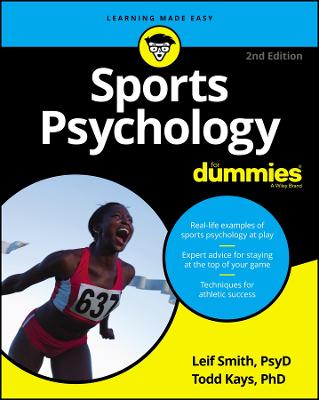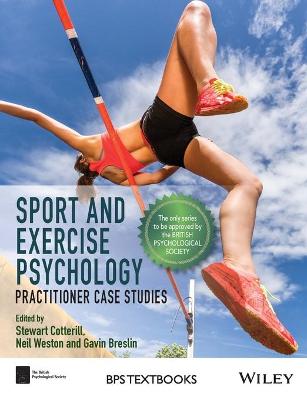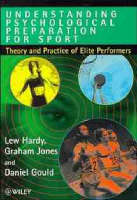Sports Psychology For Dummies 2nd Edition
 -15%
portes grátis
-15%
portes grátis
Sports Psychology For Dummies 2nd Edition
Smith, LH
John Wiley & Sons Inc
02/2022
368
Mole
Inglês
9781119855996
15 a 20 dias
684
About This Book 1
Foolish Assumptions 3
Icons Used in This Book 3
Beyond the Book 4
Where to Go from Here 4
Part 1: Getting the Winning Edge: Sports Psychology Fundamentals 5
Chapter 1: Introducing Sports Psychology and Mental Training 7
Honing Your Sharpest Weapon: Your Mind 8
Knowing how your mind influences your sports performance 9
Discovering your ideal mindset in sports performance 9
Building your ideal mindset with awareness and the right processes 10
Understanding your motivation 10
Understanding and building confidence for your athletic performance 10
Building, Preparing, and Practicing Your Mental Toolkit 11
Seeing Sports Psychology in Action 12
Knowing the Hot Trends in Sports Psychology Today 12
Becoming a Sports Psychology-Savvy Coach 13
Chapter 2: Starting with the End in Mind: Know Your Ideal Athlete Mindset 15
Tapping Into Your Ideal Mindset 16
Discovering your ideal performance mindset 17
Performing without thinking 19
Developing a Plan of Attack to Make it Consistent 19
Preparing your ideal mindset 21
Practicing your mindset 21
Assessing and improving your mindset 21
Avoiding the mindset of perfection 21
Slipping into the flow state or zone 22
Chapter 3: Setting Goals: Aiming High and Hitting the Bull's Eye 23
Setting Effective Goals 25
Determining your goals 25
Making your goals specific 28
Setting goals that challenge you 28
Setting deadlines for each goal 29
Working with tiny goals 30
Tracking Your Success in Reaching Your Goals 30
Holding yourself accountable 31
Celebrating your achievements 31
Measuring your goals 32
Giving yourself permission to adjust your goals 33
Realizing that perfection doesn't exist 34
Chapter 4: Stoking the Fire in Your Belly: How to Fan the Flames of Motivation 37
Debunking Common Myths about Motivation 38
You can get your motivation from other people 38
Fame and fortune are great motivators 38
Motivation alone can lead to success 40
Defining Motivation 40
Understanding the two types of motivation: Internal and external 40
Identifying which type of motivation is better 42
Knowing your own personal motivations 42
Assessing and Understanding Your Current Motivation Level 43
Measuring your motivation 43
Making sense of your motivation 43
Building an effective motivation plan 45
Maximizing Your Motivation: How Small Sparks Can Become Bonfires 45
Being completely honest with yourself 46
Thinking about why you play the game 46
Being curious and non-judgmental 46
Focusing on tasks, not ego 47
Finding ways to experience success 47
Mixing up your training 48
Surrounding yourself with highly motivated people 48
Being disciplined 48
Seeking support 49
Moving on from your mistakes 49
Thinking positive 49
Overcoming Obstacles to Staying Motivated 49
When your role on the team has changed 50
When you're burned out 50
When you're being pulled in different directions 51
When you're not seeing eye to eye with your coaches and teammates 52
When your priorities in life change 53
Chapter 5: Swagger: The Art and Science of Building Real Confidence 55
Understanding What Confidence Is and Why It Matters 56
Debunking Myths about Confidence: Don't Believe
Everything You See or Hear 57
Tapping into the Confidence Cycle 59
Thinking positively 60
Taking risks 61
Experiencing success 62
Building Your Confidence 63
Focusing on day-to-day success 63
Concentrating on process, not outcomes 64
Tackling the Obstacles That Get in the Way of Confidence 66
When you have a bad game 67
When you're not getting playing time 68
When you're sick or injured 68
When you aren't as prepared as you could be 70
When you are feeling pessimistic and negative 71
Part 2: Your Mental Toolkit for Success 73
Chapter 6: Tool #1: Mastering the Art of Focus 75
Understanding What Focus Is and Why It Matters 76
Where your mind goes, your energy flows 76
Limiting distractions and focusing 77
Knowing the Zones of Focus 80
Focusing on What Matters 81
Relevant points of focus 82
Irrelevant points of focus 82
Using Focus to Reduce or Eliminate Pressure 86
Overcoming the Obstacles to Focus 87
Thinking about outcomes 87
Getting caught up overthinking and overanalyzing 88
Getting too emotional 89
Letting off-the-field stuff get in the way 90
Dealing with fans, officials, and coaches 91
Developing Tools and Habits for Improving Focus 92
Chapter 7: Tool #2: Seeing Is Believing: Employing Imagery 95
Introducing Imagery 96
How imagery helps change and build better mindsets 97
Internal imagery: From your own point of view 98
External imagery: Looking at yourself from the outside 98
Determining What Type of Imager You Are 99
Visual: Monkey see, monkey do 99
Auditory: I hear you loud and clear 100
Physical: I feel you, man 100
Considering the Key Characteristics of Ideal Images 101
Painting images with vivid detail 101
Picturing images of your success 103
Getting Started with Imagery 104
What to imagine 105
When to use imagery 107
Where to use imagery 110
Setting up an imagery program 111
Evaluating the Success of Your Imagery 111
Chapter 8: Tool #3: Self-Talk: Don't Yell in Your Own Ear 115
Your Inner Critic Is Not You 116
Considering the Consequences of Self-Talk 117
The two types of self-talk: Positive and negative 117
How self-talk affects performance, mindset, and mood 118
Changing the Channel on Ineffective Self-Talk 121
Paying attention to the messages you send yourself 122
Stopping the negativity 124
Replacing ineffective self-talk with effective self-talk 125
Using Self-Talk to Improve Your Performance 128
Journaling and practicing self-talk before, during, and after practice 128
Coming up with cue words, mental anchors, and mantras 129
Creating a mental recovery routine 131
Practicing effective imagery to improve self-talk 132
Chapter 9: Tool #4: Winning Habits: How Routines Improve Performance in Competition 133
Identifying How Routines Improve Focus and Performance 136
Recognizing the Difference between Routines and Superstitions 137
Exploring the Routines of Elite Athletes 139
Example #1: First on the field 139
Example #2: Leisurely and relaxed 140
Example #3: Movies and meditation 141
Coming Up with Effective Practice and Game-Day Routines 141
Practice routines 142
Game-readiness routines 146
Post-game routines 148
Knowing When and How to Adjust Your Routines 149
Modifying your routines 150
Learning great routines from others (and making them your own) 151
Chapter 10: Tool #5: Handling Pressure: Playing with Fire without Getting Burned 153
Probing into Pressure: What It Is and Why It Occurs 154
The signs of pressure 155
What causes pressure in sports 156
Why some athletes choke under pressure 158
Pressure exists only in the mind 159
Pressure is energy steered in an ineffective direction 159
Understanding the Difference between Arousal and Pressure 160
Developing Your Ideal Mindset for Competition 164
Handling Pressure Like a Pro 164
Preparing your mind and heart to manage pressure 165
Focusing on the task at hand 165
Being prepared in every way 165
Getting perspective 167
Changing your self-talk 168
Understanding what you can control 169
Journaling 170
Breathing and stretching 171
Developing your personal plan for managing pressure 173
Chapter 11: Tool #6: Handling Adversity: The Art of Resilience 175
Resilience: Returning to a Better Mindset after a Struggle 176
Accepting adversity and mistakes as opportunities 176
Knowing that perfection is a myth 177
Developing your ideal mindset builds resilience 177
Looking at Loss Differently 178
Recognizing that loss isn't necessarily failure 178
Knowing the difference between getting beat and losing 179
Pulling Yourself Out of Slumps 180
Understanding why slumps happen 180
Focusing on fundamentals 181
Being mindful 181
Bouncing Back after Mistakes in Competition 184
Knowing what happens mentally after a mistake 184
Establishing a post-mistake routine 186
Dealing with Injuries 189
Preventing injuries 189
Coping with injuries 192
Dealing with the Fear of Reinjury 196
Chapter 12: Tool #7: Sharpening Awareness: Being Mindful 199
Being Mindful in the Moment 200
Using mindfulness to change your mind, heart, and body 201
Improving your sports performance 202
Slowing down your thoughts and emotions 202
Practicing Mindfulness 203
Practicing mindfulness off the field 203
Practicing mindfulness on the field 206
Developing a plan of action for improving mindfulness 207
Part 3: Hot Topics in Sports Psychology 209
Chapter 13: Talking About Mental Health Issues 211
Reality Check: Mental Health Issues Affect Today's Athletes 212
Debunking Mental Health Stigmas 212
Mental health issues are a sign of weakness 213
If you are mentally strong, you don't need to see a therapist/sports psychologist 213
Sports psychologists and therapists will "mess up your head" if you talk to them 213
Talking about depression and anxiety makes you less of a person 214
Understanding Anxiety Issues 214
Defining anxiety 214
Identifying common anxiety disorders 214
Understanding Depression Issues 216
Defining depression 217
Identifying common depressive disorders 217
Understanding Eating Disorders 218
Identifying common eating disorders 219
Understanding how eating disorders affect athletes 220
Determining when you need professional help 220
Additional Mental Health Issues Facing Athletes Today 221
Loss of athletics and identity to athletics 222
Recovery from injury 222
Reliance on performance enhancing drugs 222
Retirement from sports 223
Knowing Where to Turn for Help 223
Chapter 14: Managing Stress Better 225
Setting Priorities 226
Striving for Balance 226
Adding Meditation to Your Routine 227
Using Imagery to Reduce Stress 228
Managing Your Thoughts and Emotions 229
Exercising for Stress Relief 230
Making Sleep a Priority 231
Cultivating a Support Network 233
Laughing 233
Practicing Gratitude 234
Chapter 15: Making the Shift from High School to Collegiate Sports 237
Determining What Division Level to Play in College and Where to Start 238
Choosing the division that suits you 238
Seeking out advice 239
Understanding the "Recruiting Game:" Getting Noticed by Colleges 240
Finding Your Perfect Fit: What to Look for in a Coach and Program 242
Making the Jump to Collegiate Athletics 243
Approaching your first year 243
Handling first year challenges 244
Balancing Sports, Academics, and Your Social Life 245
Chapter 16: Using Sports Psychology Skills in Daily Life 247
Preparing for the Workday 247
Defining Your Career Success 248
Balancing Work and Personal Life 249
Concentrating Amid Distractions 250
Taking a Timeout from Stress 251
Performing Well Under Pressure 251
Developing Effective Work Routines 253
Focusing on Tasks Rather Than Outcomes 253
Coping with Adversity and Conflict on the Job 254
Enlisting Your Support Team 256
Chapter 17: Exploring a Career as a Sports Psychologist 257
Understanding What a Sports Psychologist Does 258
What is a sports psychologist anyway? 258
Where do sports psychologists work? 259
Sports psychologist versus mental skills consultant 260
The path to becoming a sports psychologist 260
The path to becoming a sports psychology or performance consultant 262
Determining the Right Career to Pursue 263
The clinical/counseling path: pros and cons 263
The mental skills or performance consultant path: pros and cons 264
Investigating opportunities for internships 265
Job and Career Options in Sports Psychology 265
Understanding Whether You Are Ready for a Career in Sports Psychology 266
Part 4: The Sports Psychology-Savvy Coach 269
Chapter 18: Coaching Today's Athletes 271
Improving Your Athletes' Focus 272
Preparing athletes for practice 272
Keeping athletes focused 274
Evaluating and tracking your athletes' focus 275
Teaching Your Athletes to Perform under Pressure 276
Simulating competition 276
Using imagery before, during, and after practice 277
Creating pressure-packed drills 278
Motivating Your Athletes 280
Showing athletes the big picture 281
Designing fast-moving practices 282
Finding inspiration 284
Getting Your Athletes to Play as a Team 286
Discussing the common mission everyday 286
Demonstrating how "we" is better than "me" 287
Giving teamwork more than lip service 289
Chapter 19: Mental Drills to Use with Athletes and Teams 291
Drills for Dealing with Pressure 292
Selecting material about managing pressure 292
Having your players take control of the topic 292
Creating pressure drills 292
Simulating game like-conditions 293
Bringing imagery drills to practice 293
Creating drills where the athletes do not need to think 293
Drills for Bringing Teams Together 294
Drills for Improving Communication 296
Drills for Improving Problem-Solving 297
Drills for Leadership Development 298
Part 5: The Part of Tens 301
Chapter 20: Ten Ways to Be a Better Competitor 303
Evaluate Where You Are 303
Know What Motivates You 304
Define Your Goals 304
Set an Action Plan 305
Improve Gradually and Consistently 306
Train Your Mind Daily 306
Improve Your Athletic Skills 307
Tweak Your Methods 307
Develop and Maintain Your Fitness 308
Seek Out Pressure 308
Chapter 21: Ten Ways to Parent an Athlete 311
Decide Whether to Specialize 312
Choose the Right League 313
Know What to Say after a Loss 314
Be a Fan, not a Coach 315
Cheer, Don't Yell 316
Talk with Your Kid's Coach 317
Reward the Things That Matter 317
Budget Your Time and Money 318
Focus on Learning Life Skills 319
Live Your Own Life instead of Living through Your Kid 320
Chapter 22: Ten Ways to Be a Better Leader for Your Team 321
Know Your Style 321
Know Your Teammates 322
Choose Your Moments 323
Understand Motivation 324
Find Your Sweet Spot as a Leader 324
Communicate More Effectively 325
Be Brave 327
Know When to Lead and When to Back Off 327
Take the Blame 328
Spread the Fame 328
Index 329
About This Book 1
Foolish Assumptions 3
Icons Used in This Book 3
Beyond the Book 4
Where to Go from Here 4
Part 1: Getting the Winning Edge: Sports Psychology Fundamentals 5
Chapter 1: Introducing Sports Psychology and Mental Training 7
Honing Your Sharpest Weapon: Your Mind 8
Knowing how your mind influences your sports performance 9
Discovering your ideal mindset in sports performance 9
Building your ideal mindset with awareness and the right processes 10
Understanding your motivation 10
Understanding and building confidence for your athletic performance 10
Building, Preparing, and Practicing Your Mental Toolkit 11
Seeing Sports Psychology in Action 12
Knowing the Hot Trends in Sports Psychology Today 12
Becoming a Sports Psychology-Savvy Coach 13
Chapter 2: Starting with the End in Mind: Know Your Ideal Athlete Mindset 15
Tapping Into Your Ideal Mindset 16
Discovering your ideal performance mindset 17
Performing without thinking 19
Developing a Plan of Attack to Make it Consistent 19
Preparing your ideal mindset 21
Practicing your mindset 21
Assessing and improving your mindset 21
Avoiding the mindset of perfection 21
Slipping into the flow state or zone 22
Chapter 3: Setting Goals: Aiming High and Hitting the Bull's Eye 23
Setting Effective Goals 25
Determining your goals 25
Making your goals specific 28
Setting goals that challenge you 28
Setting deadlines for each goal 29
Working with tiny goals 30
Tracking Your Success in Reaching Your Goals 30
Holding yourself accountable 31
Celebrating your achievements 31
Measuring your goals 32
Giving yourself permission to adjust your goals 33
Realizing that perfection doesn't exist 34
Chapter 4: Stoking the Fire in Your Belly: How to Fan the Flames of Motivation 37
Debunking Common Myths about Motivation 38
You can get your motivation from other people 38
Fame and fortune are great motivators 38
Motivation alone can lead to success 40
Defining Motivation 40
Understanding the two types of motivation: Internal and external 40
Identifying which type of motivation is better 42
Knowing your own personal motivations 42
Assessing and Understanding Your Current Motivation Level 43
Measuring your motivation 43
Making sense of your motivation 43
Building an effective motivation plan 45
Maximizing Your Motivation: How Small Sparks Can Become Bonfires 45
Being completely honest with yourself 46
Thinking about why you play the game 46
Being curious and non-judgmental 46
Focusing on tasks, not ego 47
Finding ways to experience success 47
Mixing up your training 48
Surrounding yourself with highly motivated people 48
Being disciplined 48
Seeking support 49
Moving on from your mistakes 49
Thinking positive 49
Overcoming Obstacles to Staying Motivated 49
When your role on the team has changed 50
When you're burned out 50
When you're being pulled in different directions 51
When you're not seeing eye to eye with your coaches and teammates 52
When your priorities in life change 53
Chapter 5: Swagger: The Art and Science of Building Real Confidence 55
Understanding What Confidence Is and Why It Matters 56
Debunking Myths about Confidence: Don't Believe
Everything You See or Hear 57
Tapping into the Confidence Cycle 59
Thinking positively 60
Taking risks 61
Experiencing success 62
Building Your Confidence 63
Focusing on day-to-day success 63
Concentrating on process, not outcomes 64
Tackling the Obstacles That Get in the Way of Confidence 66
When you have a bad game 67
When you're not getting playing time 68
When you're sick or injured 68
When you aren't as prepared as you could be 70
When you are feeling pessimistic and negative 71
Part 2: Your Mental Toolkit for Success 73
Chapter 6: Tool #1: Mastering the Art of Focus 75
Understanding What Focus Is and Why It Matters 76
Where your mind goes, your energy flows 76
Limiting distractions and focusing 77
Knowing the Zones of Focus 80
Focusing on What Matters 81
Relevant points of focus 82
Irrelevant points of focus 82
Using Focus to Reduce or Eliminate Pressure 86
Overcoming the Obstacles to Focus 87
Thinking about outcomes 87
Getting caught up overthinking and overanalyzing 88
Getting too emotional 89
Letting off-the-field stuff get in the way 90
Dealing with fans, officials, and coaches 91
Developing Tools and Habits for Improving Focus 92
Chapter 7: Tool #2: Seeing Is Believing: Employing Imagery 95
Introducing Imagery 96
How imagery helps change and build better mindsets 97
Internal imagery: From your own point of view 98
External imagery: Looking at yourself from the outside 98
Determining What Type of Imager You Are 99
Visual: Monkey see, monkey do 99
Auditory: I hear you loud and clear 100
Physical: I feel you, man 100
Considering the Key Characteristics of Ideal Images 101
Painting images with vivid detail 101
Picturing images of your success 103
Getting Started with Imagery 104
What to imagine 105
When to use imagery 107
Where to use imagery 110
Setting up an imagery program 111
Evaluating the Success of Your Imagery 111
Chapter 8: Tool #3: Self-Talk: Don't Yell in Your Own Ear 115
Your Inner Critic Is Not You 116
Considering the Consequences of Self-Talk 117
The two types of self-talk: Positive and negative 117
How self-talk affects performance, mindset, and mood 118
Changing the Channel on Ineffective Self-Talk 121
Paying attention to the messages you send yourself 122
Stopping the negativity 124
Replacing ineffective self-talk with effective self-talk 125
Using Self-Talk to Improve Your Performance 128
Journaling and practicing self-talk before, during, and after practice 128
Coming up with cue words, mental anchors, and mantras 129
Creating a mental recovery routine 131
Practicing effective imagery to improve self-talk 132
Chapter 9: Tool #4: Winning Habits: How Routines Improve Performance in Competition 133
Identifying How Routines Improve Focus and Performance 136
Recognizing the Difference between Routines and Superstitions 137
Exploring the Routines of Elite Athletes 139
Example #1: First on the field 139
Example #2: Leisurely and relaxed 140
Example #3: Movies and meditation 141
Coming Up with Effective Practice and Game-Day Routines 141
Practice routines 142
Game-readiness routines 146
Post-game routines 148
Knowing When and How to Adjust Your Routines 149
Modifying your routines 150
Learning great routines from others (and making them your own) 151
Chapter 10: Tool #5: Handling Pressure: Playing with Fire without Getting Burned 153
Probing into Pressure: What It Is and Why It Occurs 154
The signs of pressure 155
What causes pressure in sports 156
Why some athletes choke under pressure 158
Pressure exists only in the mind 159
Pressure is energy steered in an ineffective direction 159
Understanding the Difference between Arousal and Pressure 160
Developing Your Ideal Mindset for Competition 164
Handling Pressure Like a Pro 164
Preparing your mind and heart to manage pressure 165
Focusing on the task at hand 165
Being prepared in every way 165
Getting perspective 167
Changing your self-talk 168
Understanding what you can control 169
Journaling 170
Breathing and stretching 171
Developing your personal plan for managing pressure 173
Chapter 11: Tool #6: Handling Adversity: The Art of Resilience 175
Resilience: Returning to a Better Mindset after a Struggle 176
Accepting adversity and mistakes as opportunities 176
Knowing that perfection is a myth 177
Developing your ideal mindset builds resilience 177
Looking at Loss Differently 178
Recognizing that loss isn't necessarily failure 178
Knowing the difference between getting beat and losing 179
Pulling Yourself Out of Slumps 180
Understanding why slumps happen 180
Focusing on fundamentals 181
Being mindful 181
Bouncing Back after Mistakes in Competition 184
Knowing what happens mentally after a mistake 184
Establishing a post-mistake routine 186
Dealing with Injuries 189
Preventing injuries 189
Coping with injuries 192
Dealing with the Fear of Reinjury 196
Chapter 12: Tool #7: Sharpening Awareness: Being Mindful 199
Being Mindful in the Moment 200
Using mindfulness to change your mind, heart, and body 201
Improving your sports performance 202
Slowing down your thoughts and emotions 202
Practicing Mindfulness 203
Practicing mindfulness off the field 203
Practicing mindfulness on the field 206
Developing a plan of action for improving mindfulness 207
Part 3: Hot Topics in Sports Psychology 209
Chapter 13: Talking About Mental Health Issues 211
Reality Check: Mental Health Issues Affect Today's Athletes 212
Debunking Mental Health Stigmas 212
Mental health issues are a sign of weakness 213
If you are mentally strong, you don't need to see a therapist/sports psychologist 213
Sports psychologists and therapists will "mess up your head" if you talk to them 213
Talking about depression and anxiety makes you less of a person 214
Understanding Anxiety Issues 214
Defining anxiety 214
Identifying common anxiety disorders 214
Understanding Depression Issues 216
Defining depression 217
Identifying common depressive disorders 217
Understanding Eating Disorders 218
Identifying common eating disorders 219
Understanding how eating disorders affect athletes 220
Determining when you need professional help 220
Additional Mental Health Issues Facing Athletes Today 221
Loss of athletics and identity to athletics 222
Recovery from injury 222
Reliance on performance enhancing drugs 222
Retirement from sports 223
Knowing Where to Turn for Help 223
Chapter 14: Managing Stress Better 225
Setting Priorities 226
Striving for Balance 226
Adding Meditation to Your Routine 227
Using Imagery to Reduce Stress 228
Managing Your Thoughts and Emotions 229
Exercising for Stress Relief 230
Making Sleep a Priority 231
Cultivating a Support Network 233
Laughing 233
Practicing Gratitude 234
Chapter 15: Making the Shift from High School to Collegiate Sports 237
Determining What Division Level to Play in College and Where to Start 238
Choosing the division that suits you 238
Seeking out advice 239
Understanding the "Recruiting Game:" Getting Noticed by Colleges 240
Finding Your Perfect Fit: What to Look for in a Coach and Program 242
Making the Jump to Collegiate Athletics 243
Approaching your first year 243
Handling first year challenges 244
Balancing Sports, Academics, and Your Social Life 245
Chapter 16: Using Sports Psychology Skills in Daily Life 247
Preparing for the Workday 247
Defining Your Career Success 248
Balancing Work and Personal Life 249
Concentrating Amid Distractions 250
Taking a Timeout from Stress 251
Performing Well Under Pressure 251
Developing Effective Work Routines 253
Focusing on Tasks Rather Than Outcomes 253
Coping with Adversity and Conflict on the Job 254
Enlisting Your Support Team 256
Chapter 17: Exploring a Career as a Sports Psychologist 257
Understanding What a Sports Psychologist Does 258
What is a sports psychologist anyway? 258
Where do sports psychologists work? 259
Sports psychologist versus mental skills consultant 260
The path to becoming a sports psychologist 260
The path to becoming a sports psychology or performance consultant 262
Determining the Right Career to Pursue 263
The clinical/counseling path: pros and cons 263
The mental skills or performance consultant path: pros and cons 264
Investigating opportunities for internships 265
Job and Career Options in Sports Psychology 265
Understanding Whether You Are Ready for a Career in Sports Psychology 266
Part 4: The Sports Psychology-Savvy Coach 269
Chapter 18: Coaching Today's Athletes 271
Improving Your Athletes' Focus 272
Preparing athletes for practice 272
Keeping athletes focused 274
Evaluating and tracking your athletes' focus 275
Teaching Your Athletes to Perform under Pressure 276
Simulating competition 276
Using imagery before, during, and after practice 277
Creating pressure-packed drills 278
Motivating Your Athletes 280
Showing athletes the big picture 281
Designing fast-moving practices 282
Finding inspiration 284
Getting Your Athletes to Play as a Team 286
Discussing the common mission everyday 286
Demonstrating how "we" is better than "me" 287
Giving teamwork more than lip service 289
Chapter 19: Mental Drills to Use with Athletes and Teams 291
Drills for Dealing with Pressure 292
Selecting material about managing pressure 292
Having your players take control of the topic 292
Creating pressure drills 292
Simulating game like-conditions 293
Bringing imagery drills to practice 293
Creating drills where the athletes do not need to think 293
Drills for Bringing Teams Together 294
Drills for Improving Communication 296
Drills for Improving Problem-Solving 297
Drills for Leadership Development 298
Part 5: The Part of Tens 301
Chapter 20: Ten Ways to Be a Better Competitor 303
Evaluate Where You Are 303
Know What Motivates You 304
Define Your Goals 304
Set an Action Plan 305
Improve Gradually and Consistently 306
Train Your Mind Daily 306
Improve Your Athletic Skills 307
Tweak Your Methods 307
Develop and Maintain Your Fitness 308
Seek Out Pressure 308
Chapter 21: Ten Ways to Parent an Athlete 311
Decide Whether to Specialize 312
Choose the Right League 313
Know What to Say after a Loss 314
Be a Fan, not a Coach 315
Cheer, Don't Yell 316
Talk with Your Kid's Coach 317
Reward the Things That Matter 317
Budget Your Time and Money 318
Focus on Learning Life Skills 319
Live Your Own Life instead of Living through Your Kid 320
Chapter 22: Ten Ways to Be a Better Leader for Your Team 321
Know Your Style 321
Know Your Teammates 322
Choose Your Moments 323
Understand Motivation 324
Find Your Sweet Spot as a Leader 324
Communicate More Effectively 325
Be Brave 327
Know When to Lead and When to Back Off 327
Take the Blame 328
Spread the Fame 328
Index 329











